(First published April 2020 during the Coronavirus lockdown)
If you find yourself in need of some at-home ideas, we’ve put our heads together to come up with a list of ideas of things to do at home using resources you will hopefully have at home or may be able to acquire easily.
These ideas vary in age range so some will be suitable for younger children and some for older and some can probably be adapted to suit everyone.
Arts & Crafts
1. Make playdough then have fun playing with it. Make different colours for added fun. Use cookie cutters, paper scissors, blunt knives to mould, shape and create.
Makes 1 ball
Prep 10 minutes
Cook 3 hours
250g Plain flour
125g Table Salt
125ml Water
Preheat the oven to its lowest setting and line a baking tray
Mix the flour & salt. Add the water and stir until it becomes a ball.
Roll out the dough onto a floured surface and cut into shapes (get creative!) If you’re making hanging decorations remember to punch the hole before cooking.
Put onto the baking tray and bake for around 3 hours until firm. Leave to cool.
2. Sewing. Raid your sewing box for needles and thread. Find some scrap materials or old clothes that you haven’t taken to the charity shop yet (you could combine this activity with #68 in our list and get the children to help with clearing out their wardrobes first) and teach your children to sew. If they already know then they could search the internet for ideas of simple things to make.
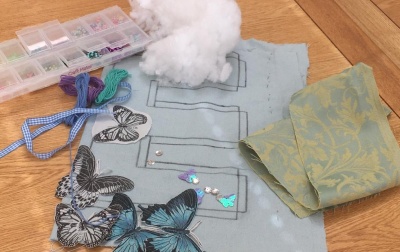
3. Make pom-pom animals with leftover wool - This is a great article on how to make basic pom-poms to get you started.
4. Use up those craft kits, science kits, art kits that the kids have been given over the years for birthdays and which you never normally have time to finish (or start!) You could combine this with #67 in our list and get the children to help with a big toy clear out to find them all first.
5. Have a “crafternoon”. Get out all the paints, glitter and craft stuff. Cover the table with an old tablecloth or newspaper and let them get creative. Sit down with them to enjoy creating something of your own - they’ll be much more into it if you join in too. Towards the end, run a bath so you can pop them straight in when they are covered from head to toe in paint.
6. Find photos of family & friends (birthday parties, playdates etc, older kids probably have loads on their phones!) print them off and create a collage, poster or board. You could even think ahead and make a Mothers' Day present using all those photos of your mum...!
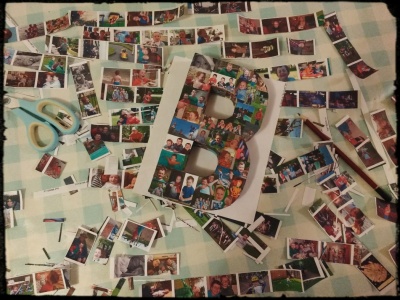
7. Make slime –
Makes 1 ball
Takes 10 minutes
100ml PVA glue (kids craft gloopy glue)
½ tsp bicarbonate of soda
food colouring
1 tsp contact lens solution
Mix the glue, bicarbonate of soda and food colouring (keep adding until you get a bright colour!). Add the contact lens solution to the mixture and the slime will start to form. Knead it like dough into a ball. For tips on texture slimy solutions check out BBC Good Food.
8. Don’t throw your cardboard into the recycling just yet. Keep it and have fun junk modelling. Spaceships, rockets, whole towns for your teddies, castles and just awesome crazy models!
9. Hunt out some old tin cans or plastic cups and some string and make “telephones”. Try a game of whispers and see how quietly you can get a message from one person to another.
10. Make your own musical instruments using yoghurt pots, Tupperware tubs, elastic bands, saucepans, wooden spoons, rice, pasta, lentils etc, and create a band. (Don’t worry, you can take them apart later to use the pasta and rice for dinner!)
11. Make your own perfume or potion. You can use things from the garden. Or things from the kitchen.
12. Make a scrapbook – find an old notebook or jotter or create your own from scrap paper. Use photos, or search drawers and cupboards for old memorabilia that you can stick in and decorate.
13. Papier maché – with so much time on our hands you could go big with this one!
14. Easter is coming, so hard boil some eggs and enjoy painting them with paints or felt tips. Then later you can enjoy them for lunch perhaps as part of an indoor picnic (see #38).
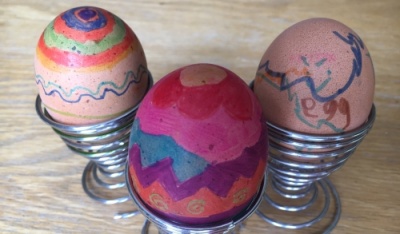
15. If you have some old sock lying around make sock puppets - use scraps of fabric for ears and old buttons for eyes and nose! Glue them on, or if the children have mastered sewing (see #2) then stitch them on.
16. If your children enjoy colouring try the 3-colour challenge! Print off a colouring sheet for each person (the same one). Put all your felt tips (or pencils or crayons) in a bag and each person chooses 3 at random. Colour your picture with only those colours. See how they each turn out and choose your favourite. You'll be amazed at the differences! If you need some colouring sheets to download Crayola have lots free on their website including a whole host of Disney-themed ones or how about these lovely doodles from local Illustrator Laura Hambleton.
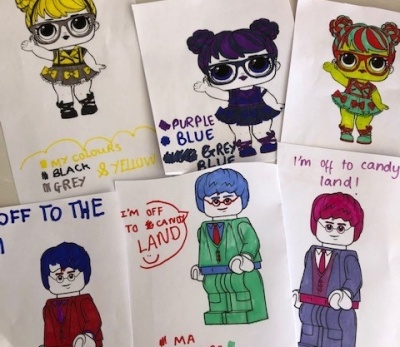
17. Rock painting and hiding is still going strong around town. Decorate rocks with colourful designs and pictures using paint or sharpies. If you can seal them with varnish or PVA glue this will help preserve the designs from the weather. Then hide them for people to find on their walks and keep an eye for some yourself. If you find any you can post them on the Harpenden Rocks Facebook group and then hide them somewhere else to be found again. There is also an NHS Rocks Facebook page for rocks celebrating the NHS.
Indoor Fun
18. Make some fun quizzes. Prepare one for your children then get them to make their own for you and/or siblings.
19. Create a Treasure Hunt with clues for the children to follow and a treat as a prize at the end. You can do this in the house or in the garden. Then let the children have fun creating one for you. For younger children let them help you make a treasure map or leave pictures of where the next clue is hidden.
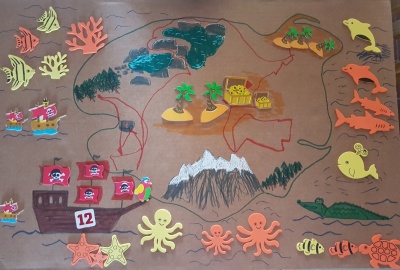
20. Create an indoor or outdoor obstacle course then take it in turns to time each other and see who can do it fastest.
21. Make a cotton ball spiderweb. Using masking tape create a web across a corridor or a whole room if you’re feeling brave. Then have fun throwing cotton wool balls at the tape.
22. Make an indoor scavenger hunt. Send the children around the house looking for items to bring back. Some ideas might be – a scarf, a teddy, a badge, a pencil, a sharpener, a toothbrush etc. Or find 10 things starting with the letter ‘s’.
23. Taste testing. Prepare a few different foods and drinks and then blindfold the kids to see if they can identify them. Could do the same with smells. (My kids love doing this on me too. Just make sure they know not to try feeding you chilli powder!)
24. Hunt the button. Choose a small item. One person remains in the room whilst the others all go out. Then that person hides the item – but it has to be in view. They all come back in the room and look for the item. The first person to see it doesn’t say anything but sits down. The next person when they spot it does the same. Etc. Until the last person to spot it is the person to hide the item next time.
25. Toy guessing. Gather together a number of different toys (eg. Train, car, marble, lego block, book, teddy) and put them under a large cloth or sheet. Each child then takes it in turn to feel the toys and guess what they are – by writing them down.
26. Secret codes. Create your own codes and write a message in your code and see if you or other siblings can decipher it. (e.g. A = 1, B = 2)
27. Build a den in the house or outdoors.
28. Make paper aeroplanes and paper boats. Use the internet to find different shapes and styles to try them out. Which aeroplanes fly furthest? Test the paper boats in the bath or sink and try racing them.
29. Have a board game marathon! Or why not play remotely with friends and family - a great way to involve people who may be isolated and in need of company. Pick a simple game with a dice e.g. snakes & ladders or frustration. One person can control the board and pieces and everyone else just needs a dice to roll. Or if you have the same game that doesn't required a board you could play together distantly for example Yahtzee or Pass the Pigs.
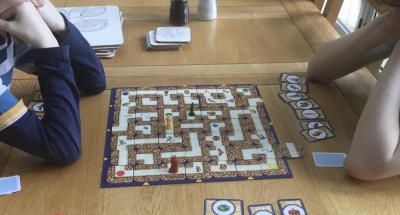
30. Do a jigsaw as a family. Find a large jigsaw (500 to 1000 pieces). Set it up somewhere that it can stay for a while and encourage everyone to get involved and have a go. You can dip in and out of it until it’s complete.
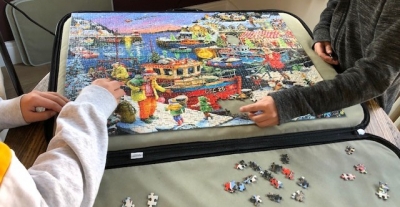
31. Devise a show/performance/play or take it one step further and use your phone camera and make a movie! If your kids are older, download some free video editing software so they can edit it adding sound effect, titles, etc. Need help getting started? Put 5 items in a bag and use them to make up a play.
32. Play the story writing game - take turns to add a line or two at a time - see how long you can keep it going. Or for younger children play picture consequences – start with the head, the next person adds the body and so on.
33. If you can find an odd balloon lying around blow it up and have a keepy-uppy competition. Either individually or as a family. Don’t let it touch the ground!
34. Memory game – tray of items from around the house, give them a minute to memorise them and then take one away. See if they can spot what has been removed.
35. Learn some jokes then make up your own
36. Learn to juggle with tennis balls (avoid using fruit for this activity!)
37. Paint a wall. WARNING: I let the children do this when we were forced into isolation a few years ago with one of them very ill with flu. The others painted a wall that was going to be knocked down at some point in the near future…4 years later and it hasn’t yet been knocked down!
38. Have an indoor picnic. Get the blankets out, the picnic basket, plastic plates. After eating your fill, lie back, imagine the sun shining and tell each other the jokes you learnt in #35!
Educational
39. Older children might like to undertake a project. Find topic idea that interests them - a particular country, a certain category of animals, a period of time in history. Give them a spare notebooks or paper that they can make into a booklet.They can decorate it in their theme to make it look good and start their project in there, then use any reference books you have or the internet to research and fill their book.
40. Educational TV - sit down and watch Horrible Histories together or Blue Planet.
41. Try out some homemade science experiments. Try heading here for some ideas and the James Dyson Foundation have released some brilliant ideas to try at home.
42. Learn a new skill (or the basics anyway) using online resources or books if you have them. Here’s some ideas:
- Touch typing – there are some great programmes out there like www.typing-fingers.com or www.keybr.com A bit each day will have them started in no time.
- A foreign language or saying hello and thank you in as many languages as possible
- Coding – e.g. Scratch (try Barclays Code Playground tutorials) or for older students try HTML to learn to build websites (e.g. W3C HTML Tutorial)
- British Sign Language or Makaton
- Morse code –– try sending messages to each other tapping a pencil on the table
- Learn to tie different knots
- Yoga poses
- Basic first aid
- Knitting/crocheting
43. Learn to read a map – print a map of the local area from Google (or equivalent). Identify landmarks – your home, school, church, shops etc. get them to right directions to get from place to place. If you have a compass teach the children how to use it too.
44. Learn to play Chess. Try chesskids.com (basic membership is free) or chess.com. Both provide lessons on how to play a chance to practice playing against the computer and then once your child has mastered it they can play against other children. If they already know how to play, chess.com are running kids tournaments daily 6-7pm at the moment.
45. Learn about the weather:
46. Write a short book about your favourite toy or your best friend and the adventures you go on.
47. Paint flags on stones and place the stones on a map on the correct country.
If you have a garden
48. Get out in the garden and do some spring tidying - pull out some weeds, cut back old dead plants, turn over the soil, wash out pots and containers ready for summer.
49. Plant some giant sunflower seeds in yoghurt pots or carrots and potatoes to be ready for the summer. You might start your own vegetable patch and start living The Good Life!
50. Mini beast hunt. Spend time searching for insects, creepy crawlies, bugs etc.

51. Learn the names of some of the spring flowers. If you have some in your garden, you could press them and use them for a picture or to make cards in a few weeks.

52. Do your own Garden Bird Watch. Get the binoculars out and sit for an hour watching your garden and make a note of how many of each bird type you see. Lookup any you don’t know.
53. Take a ball and make a goal of some sort (a waste paper basket or garden tub works well for this) and see how far away you can be and still get the ball in. Make it harder by trying in different ways – under the leg, over your head backwards etc.
54. Set up a limbo competition using a skipping rope and see how low you can go (you might be able to do this one indoors too).
55. Set up a long jump competition - find a long measuring tape and lay in on the ground (a grassy surface is best for this) use a stick or rope to act as the jumping marker, allowing space for a run-up and see who can jump the furthest. Or make up some other competition like how many keepy-uppies can you do (no headers please!).
56. Make an outdoor scavenger hunt. Send the children around the garden looking for items to bring back. You’ll need to adapt for your own garden but some ideas might be – a pine cone, a snail shell, a small pebble, a daisy a small stick, a yellow leaf etc.
57. Learn to skip with a rope, to do a handstand or to do a cartwheel.
58. Got some chalk lying around? Let the children release their creative flair with some chalk art outside in the garden on the patio or driveway.
59. Draw a chalk challenge on the patio to jump a square, hop two squares, spin around, walk on all fours etc
60. Draw a chalk racetrack for all those remote-control vehicles in the cupboard. Or a smaller version for the toy trucks and cars. You can add a petrol station, supermarket and pharmacy to visit in your toy car!
61. Bubbles! If you have no solution just use washing up liquid and a little water.
62. If it's a dry day "paint" on the ground with water and and an old paint brush. If the sun is out watch your masterpieces disappear, and then start again!
Home Help
63. Look to see what you have in your baking cupboard and get baking. Dust off those recipe books or have a look on the internet for ideas of things to bake. BBC Good Food is a great app/website to get you started.
Flapjacks are simple and easy if you have:
100g of butter
100g of golden syrup
100g of demerara sugar
225g oats
Measure everything except the oats into a saucepan and melt over a low heat.
When everything has melted turn off the heat and stir in the oats.
into a lined baking dish and put in the oven for 12 minutes at 160 degrees (fan oven).

63. Get the children to prepare a restaurant meal including a menu, tablecloth and waiter service! It can be as simple as fish & chips and ice-cream but parents aren’t allowed to help!
64. Get out and wash the car and hoover it too!
65. Let them help with washing up. Little ones love this. Make it nice and soapy so they can enjoy playing with the bubbles. You’ve also now managed to get them to wash their hands without trying!
66. Before you start any colouring or arts & crafts, sort through all your pens and recycle the ones that no longer work. Sharpen all your pencils. (I did this today and it brought back memories of being at primary school!) If you have too many wax crayons you can melt them in silicon baking trays to make decorations.
67. Tidy out the toy cupboard and enjoy playing with old, long-forgotten toys then clean and bag up old ones to go to charity later.
68. Tidy out drawers and wardrobes. Have fun dressing up in old clothes to see what still fits. Have a fashion parade and then bag up anything that’s too small for charity (or save some old scraps for a sewing project - see #2).
69. For older children, teach them some new housework skills e.g. ironing, washing their clothes, polishing and dusting, polishing shoes. They’ll be ready to leave home by the end of this!
70. Write a postcard or paint a picture for someone in an old people’s home. If they can’t receive post, take a photo of the picture or letter and email it to their office. This way you could share your thoughtfulness with several care homes.
71. For older children, get them to find all the school uniform where the labels have fallen off (or that you never actually got round to labelling in the first place) and get the children to relabel them. If you have sew on badges and the children can or are learning to sew this is perfect because you don't need neat sewing for this! Or what about those Guide and Scout badges that haven't made it onto the uniform yet?
72. Make a day of getting everyone involved in spring cleaning a room in the house.
73. Get on with all those DIY tasks you've been putting off and get the kids to help - teach them some basic skills... fix that squeaky door or that wonky shelf ... or if you are a real DIY enthusiast go big...
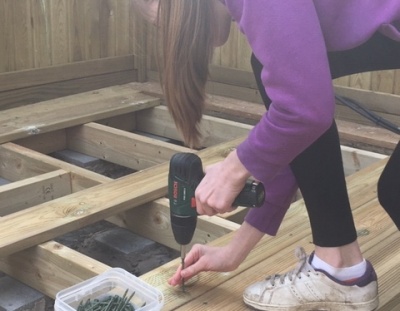
Even more ideas...
74. Encourage the children to write a letter to a friend or relative. Do you have an older relative that lives far away or is isolating? They’d appreciate receiving a letter. Even just a letter to a friend from school. They may be constantly exchanging messages on Instagram or WhatsApp but letters are special. They can take their time, write it over a few days, decorate it, draw pictures... discover the joy of this “old-fashioned” method of communication!
75. Keep a diary or a journal. These are exceptional times and it will make an interesting read in the future.
76. Who do you think you are? Research your family tree - you never know what you might discover! Try and source information from old birth, marriage and death certificates if you have them, and when you've exhausted those get online. Here's some resources to get you started - some are free, others will provide some information for free, some charge a fee but may offer a free trial:
77. It seem obvious, but reading! Libraries are (at the time of writing) still open. But if you are a member of Hertfordshire Libraries (other libraries will not doubt offer a similar service) then you just need to download the Borrowbox app and have your library card handy, to enable the children (and you) to access hundreds of eBooks and audiobooks for free. And there's no overdue charges! Also Audible have announced that they are making all children's audioooks free on their streaming service.
78. We stole this one from Blue Peter in the 80s - make a Time capsule and bury it in your garden (or hide it somewhere else if you don’t have a garden). Use a suitable container and fill it with small items, news clippings, photos and notes that represent 2020. Try and make sure the contents are kept safe from the elements. You’ll have fun discovering it again sometime in the future - or perhaps someone else will find it and get a glimpse into life during the COVID-19 pandemic!
79. Have a "spa day"! Get out all those beauty sets that you got for Christmas and have a fun, feel-good time together as you turn your home into a salon. Style each other's hair, paint fingernails and toenails, apply a face mask - dressing gowns essential of course!
80. Go on a rainbow and a teddy hunt. More and more people are putting rainbows and teddies in their windows to cheer everyone up and as a sign of being in this together. Go on a walk and see how many you can spot in your area.
81. Make your own rainbow to put in the window. Freestyle it, print off a colouring sheet from the internet or (for your window) go big... how about this idea so you don't block all the light from the window - paint it onto cellophane...
82. Have an Easter egg hunt. Buy some mini chocolate eggs and hide them around the house or garden and let the children have fun finding them, and even more fun eating them!
83. Go on a virtual tour of the world. Have a look at our Tour the World from you Sofa article with details of the best web cams and virtual tours around the world.
84. Write a letter, poem or story or create a drawing, or demonstrate your passion for music or the environment, send your work to Blue Peter and see if you can earn a badge.
85. If your child is part of the scouting or girl guiding movements they could use this time to be working towards some badges. You can find details of all the badges for Beavers, Cubs, Scouts, Explorers and all sections of Girl Guides on their websites.
86. How about having a family Escape Room Experience at home? clueQuest have one available to download for a fee (£12 at the time of writing). MGT Tips: make sure you do all the printing and cutting before you start the game. Follow the instructions carefully and keep everything you have prepared in the right order!
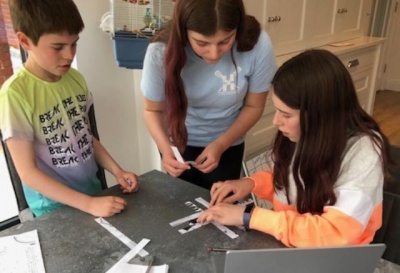
87. Do your children love Lego? How about creating your own Lego challenges? They can be long challenges - decide a theme or an object and everyone has to create the best example they can e.g. a boat, a dinosaur, a car etc. Or short - everyone starts with the exact same set of bricks and has to be as inventive as they can. See who can come up with the best creation.
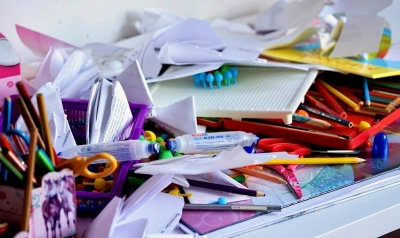








 Browse the site
Browse the site






